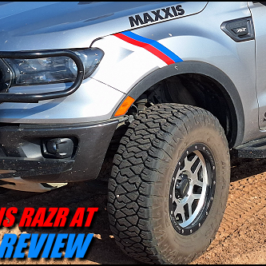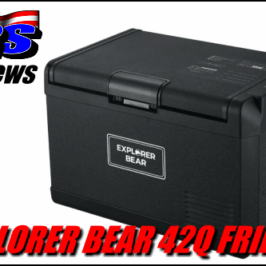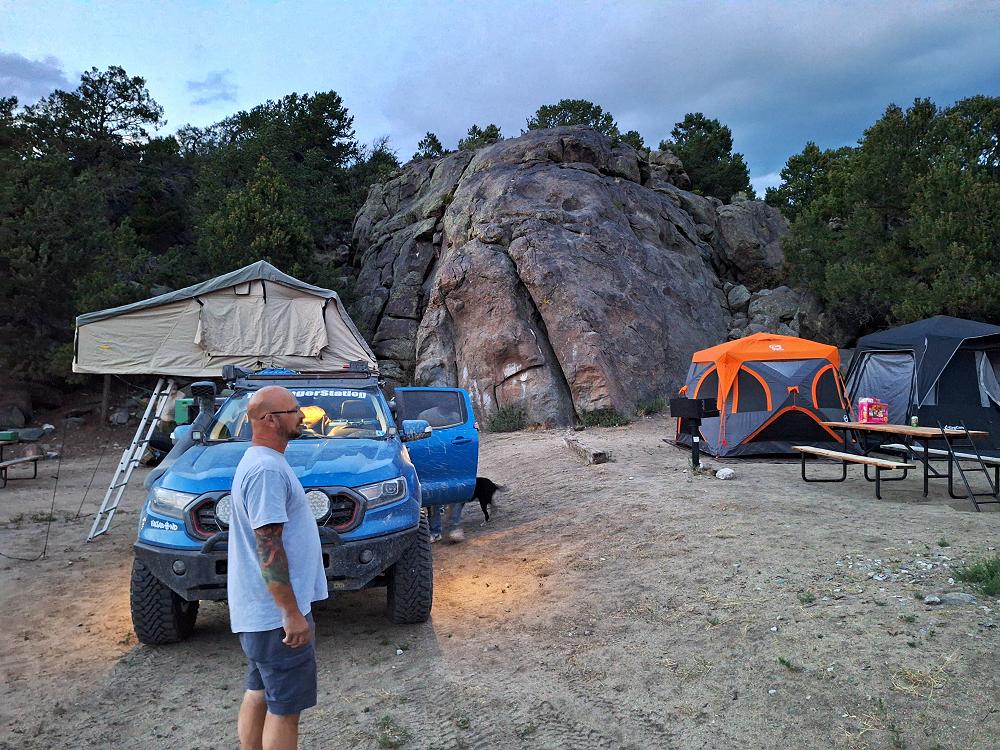
Introduction
Rooftop tents have exploded in popularity in the overlanding world, but they are an expensive and not necessarily the right choice for everyone. I have been overlanding since 2017 and have experience using both rooftop tents and ground tents. Let’s discuss the options and what might be right for you.
Table of Contents
- My Recent Experiences
- Using a Ground Tent
- Popular Ground Tent Models
- The Draw to Rooftop Tents (RTT)
- Rooftop Tent Styles Explained
- Popular RTT Models
- Pros & Cons: RTT vs Ground Tent
- Conclusion & Recommendations
- Related Links
- About The Author
My Recent Experiences
When the Vagabonds and I attended Overland Expo Mountain West, it felt like we were surrounded by a sea of rooftop tents. It’s easy to get caught up in the idea that you need one simply because everyone else has one. I often joke that spotting a Rotopax on someone’s rig is like the engagement ring of overlanding—while mounting a rooftop tent is the wedding band. Those two items almost feel like the unspoken “requirements” of the lifestyle. But do you really need them? The short answer is no.
Overlanding has grown into a massive industry with big profits, and just like weddings, it has a way of driving up the cost of even the simplest products.
I’ve been fortunate to experience both sides of the debate, taking cross-country trips with a rooftop tent as well as with a ground tent. For example, I used a rooftop tent on the 2019 Ford “Loan” Ranger during my Trans America Trail adventure. More recently, the Vagabonds and I completed a 12-day trip through Colorado where we used a mix of rooftop tents and ground tents—an experience that further shaped my perspective on camping setups.
So, what follows is my personal feedback based on real-world use to help you decide what might work best for you. For the record, I haven’t been given any free tents, nor do I have any reason to sway your opinion. What you’ll read here is simply my experience—nothing more, nothing less.
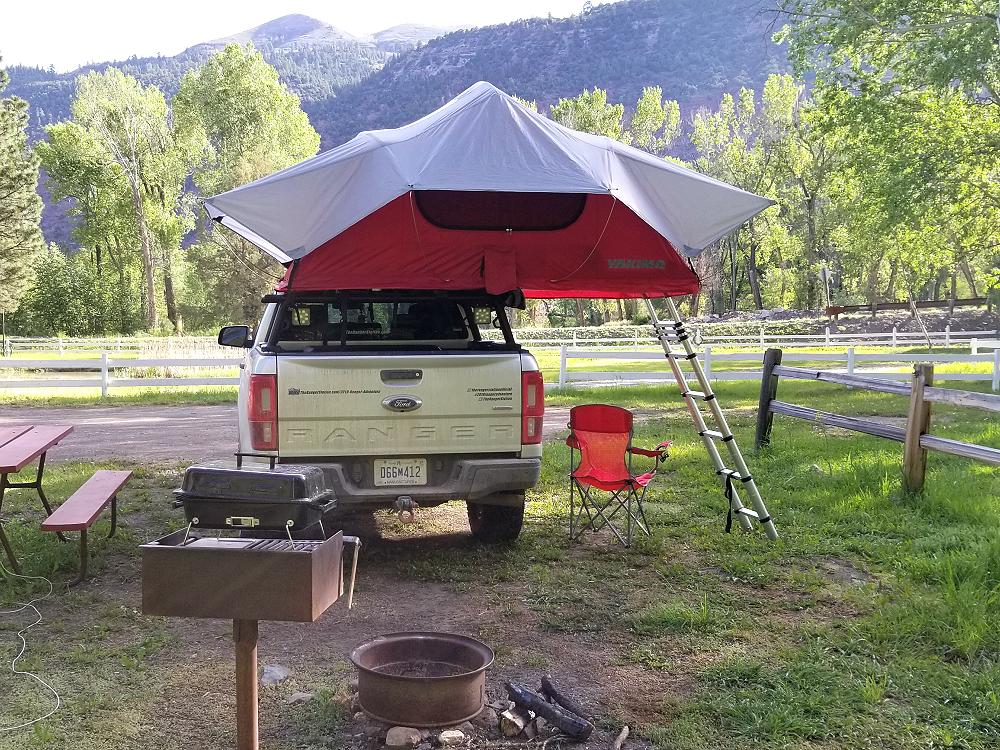
(I used the Yakima rooftop tent while doing the Trans America Trail)
Using A Ground Tent
I spent more than 20 years camping in a Hillary ground tent that I originally bought from Sears. I know it came from Sears because it had their logo printed on the inside—a constant reminder of just how old the tent was, and that it might be time to start shopping for a replacement. That, combined with the frustration of wrestling with the poles and trying to set it up by myself, finally convinced me it was time for an upgrade. So for 2024, I decided to invest in a new tent.

I originally had my eye on the Gazelle T4 tent. Fellow Vagabonds Robbie and Eric both use one, and I know from experience that they’re well-built and incredibly fast to set up. The T4 features a 210-denier Oxford weave polyester shell and a 300-denier Oxford weave polyester floor. When pitched, it measures 94″ x 94″ with a 78″ peak height, but when packed down it’s 67.5″ in length and weighs about 30 lbs.
While researching, I came across Best Instant Tent in 2023: Detailed Reviews, which listed the Caddis Rapid 4 Tent just below the Gazelle. The Rapid 4 uses a 190-denier polyester shell with a 210-denier polyester floor. It sets up to 96″ x 96″ with a 72″ peak height, but when packed it’s only 50″ long—significantly shorter than the Gazelle—and weighs 20 lbs. 8 oz.
Like many modern instant tents, both the Gazelle and Caddis feature poles integrated into the design, so all you need to do is open them up and stand them upright. Either tent can be pitched in about 90 seconds, with a total setup time of around five minutes once it’s staked down and the rainfly is installed.
In the end, I chose the Caddis Rapid 4. The Gazelle’s extra 6 inches of headroom was tempting, but it also came with 17.5 inches of added packed length and nearly 10 extra pounds. With the limited space in my truck bed and the rack I use for gear, the more compact and lighter Caddis was a better fit. Plus, the Gazelle simply wouldn’t fit in my rack.
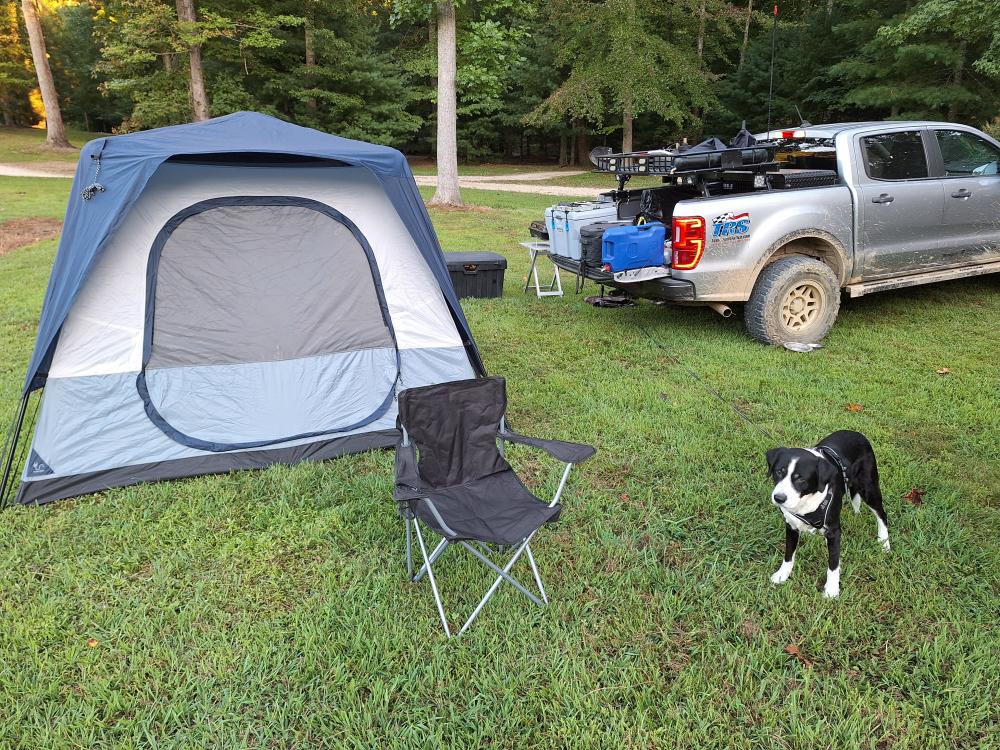
(My Caddis Rapid 4 Tent)
Some of The Most Popular Ground Tents
| Model | Summary | Weight |
Size Packed Open |
People |
|---|---|---|---|---|
| Caddis Rapid 4 | All-around instant cabin;
tall ceiling, durable, quick setup |
20.5 lb | 9″×9″×50″
96″×96″×80″ |
4 Person |
| Gazelle GT400R T4 | Durable pop-out hub; easy pitch;
solid weather protection |
32 lb | 8″×8″×67″
94″×94″×78″ |
4 Person |
| Teton Sports Vista | Lightweight, budget-friendly,
fast pitch, compact |
6.3 lb | 7″×7″×33″
82″×60″×41″ |
1–2 Person |
| Core 9 Instant Cabin | Large floor space; 2 rooms;
good for family basecamp |
27.6 lb | 11″×12″×48″
168″×108″×78″ |
9 Person |
| Zempire Pronto 5 V2 | Premium inflatable frame;
great ventilation; fast setup |
32.3 lb | 16″×10″×28″
109″×109″×75″ |
5 Person |
| Coleman 4-Person
Instant Cabin |
Affordable; very quick setup;
best for fair weather |
18.2 lb | 8″×8″×40″
96″×84″×59″ |
4 Person |
The Draw To Rooftop Tents (RTT)
Rooftop tents (RTTs) have exploded in popularity in recent years, especially within the overlanding and off-road community. Part of the draw is convenience—RTTs are mounted directly to a vehicle’s roof rack, so your sleeping space travels with you wherever you go. Setup is usually quick, often just a matter of unclipping the cover, unfolding the tent, and extending the ladder. This simplicity appeals to people who want to maximize their time exploring and minimize the hassle of pitching camp at the end of a long day.
Another reason people gravitate toward RTTs is comfort and security. Sleeping above the ground keeps campers away from rocks, mud, uneven terrain, and critters. Many models include built-in mattresses, which provide a far more comfortable sleeping surface than the thin pads commonly used in ground tents. Being elevated also offers a sense of safety—whether it’s from wildlife in the area or simply from the peace of mind that comes with being off the ground.
Finally, RTTs have become a symbol of adventure and self-sufficiency. Much like adding a winch or roof rack, mounting a rooftop tent signals readiness for the outdoors. For many, it’s not just about function but about lifestyle—the idea that with a tent already attached, you can take off on a spontaneous trip at a moment’s notice. While they come at a higher cost and add weight to a vehicle, the blend of convenience, comfort, and image continues to make rooftop tents an appealing choice over traditional ground tents.
Rooftop Tent Styles Explained
Soft Shell Rooftop Tent
Soft shell RTTs are the most common and affordable style. They use a folding design where the tent body is made of heavy-duty fabric and expands outward from a hinged base. Setup usually requires removing a cover, unfolding the platform, and extending the poles. Their biggest advantages are low cost, large sleeping area, and flexibility in sizes. However, they take longer to set up and pack away compared to hard shell options, and the fabric cover can be a hassle in bad weather.
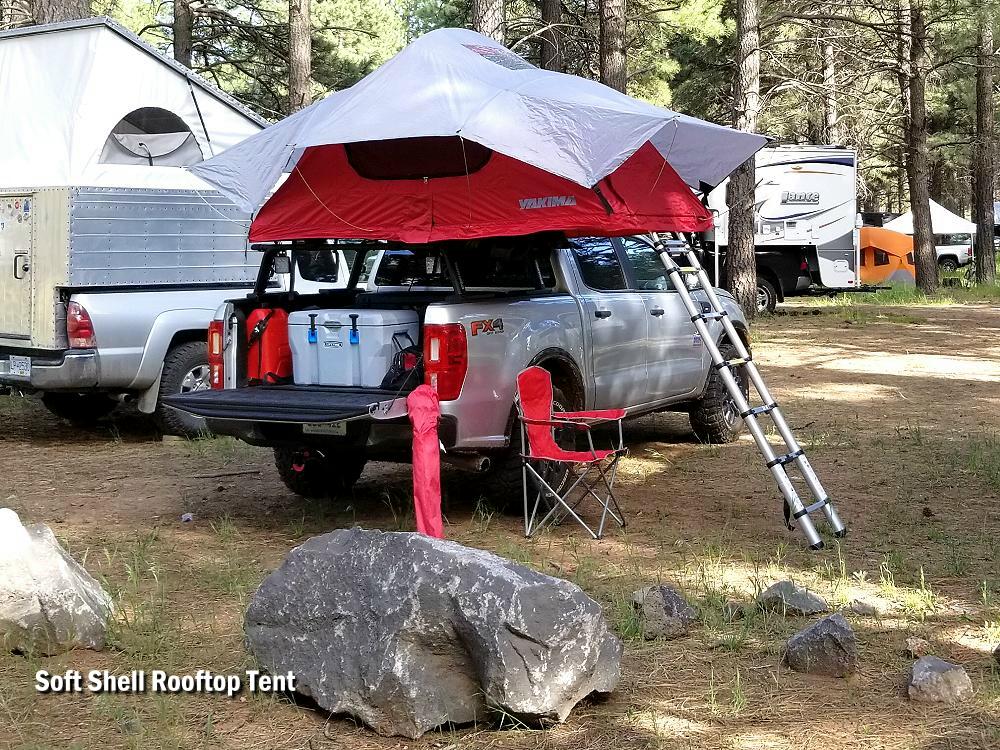
Hard Shell Rooftop Tent
Hard shell RTTs use a rigid top and bottom shell, typically made of fiberglass or aluminum, that clamp shut when stored. They pop open quickly with gas struts or hinges, making them much faster to deploy than soft shells. Hard shells are aerodynamic, durable, and weather-resistant, and many support gear storage on top. Their main drawback is cost—they’re typically more expensive and offer less floor space than fold-out designs.
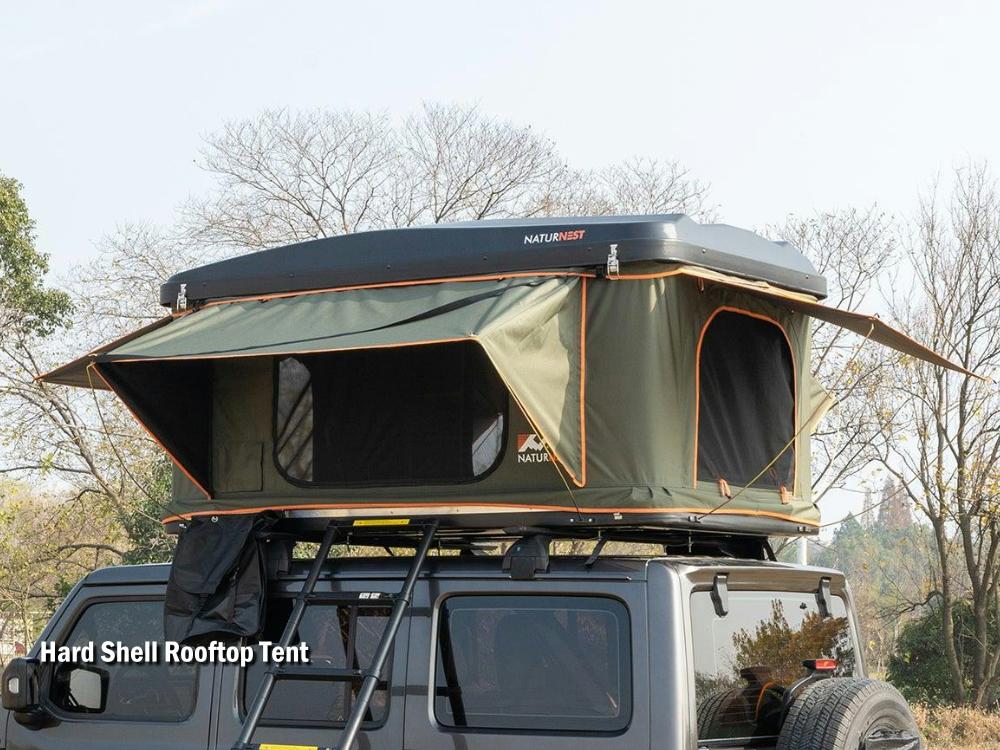
Hard Sided Rooftop Tent
Modern RTT designs include “hard-sided” fold-out options that combine the durability of a hard shell with the roominess of a fabric tent. When closed, the rigid cover protects the tent and eliminates the need for a separate fabric bag. When opened, the shell becomes part of the roof while the platform unfolds to double the sleeping area—similar to a soft shell RTT. This design is quicker to pack, more aerodynamic on the road, and can be built in both two- and four-person layouts.
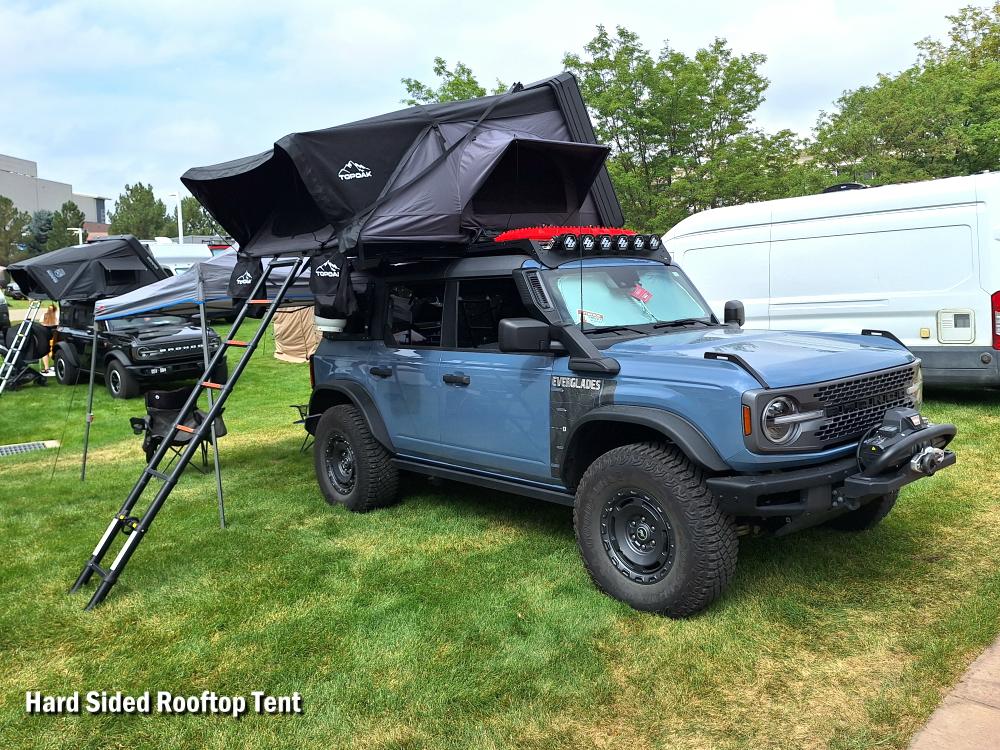
Clamshell Rooftop Tent
Clamshell RTTs hinge open at one end, creating a triangular profile when deployed. They are incredibly fast to set up, often requiring just a couple of latches to release. The tent pops open and holds its shape with minimal poles. Their biggest strengths are durability, speed, and ease of use. However, they only allow entry from the hinged “south end,” which can limit accessibility and usable interior space compared to wedge tents.
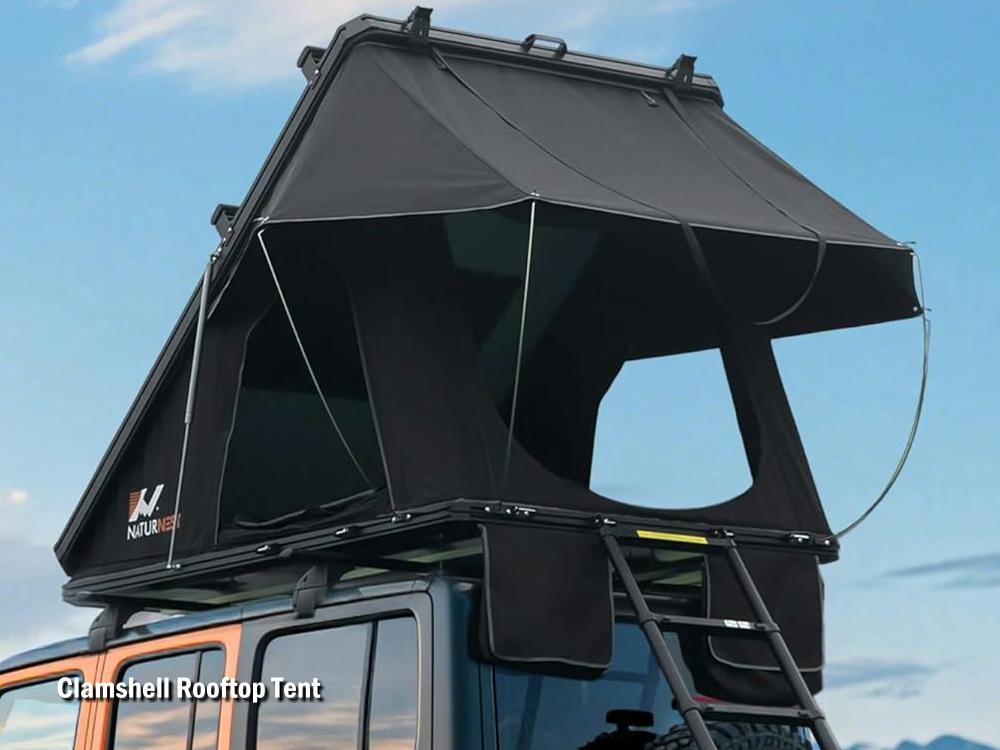
Wedge Style Rooftop Tent
Wedge-style RTTs are similar to clamshells but offer more versatility. They also hinge at one end, but can be entered from either the side or the end of the tent. This makes them more user-friendly, especially for vehicles with different rack layouts. Wedge tents often allow for taller headroom at one side, making them great for sitting up or changing clothes inside. Like clamshells, they are durable, aerodynamic, and quick to deploy, though they typically provide less sleeping space than fold-out tents.
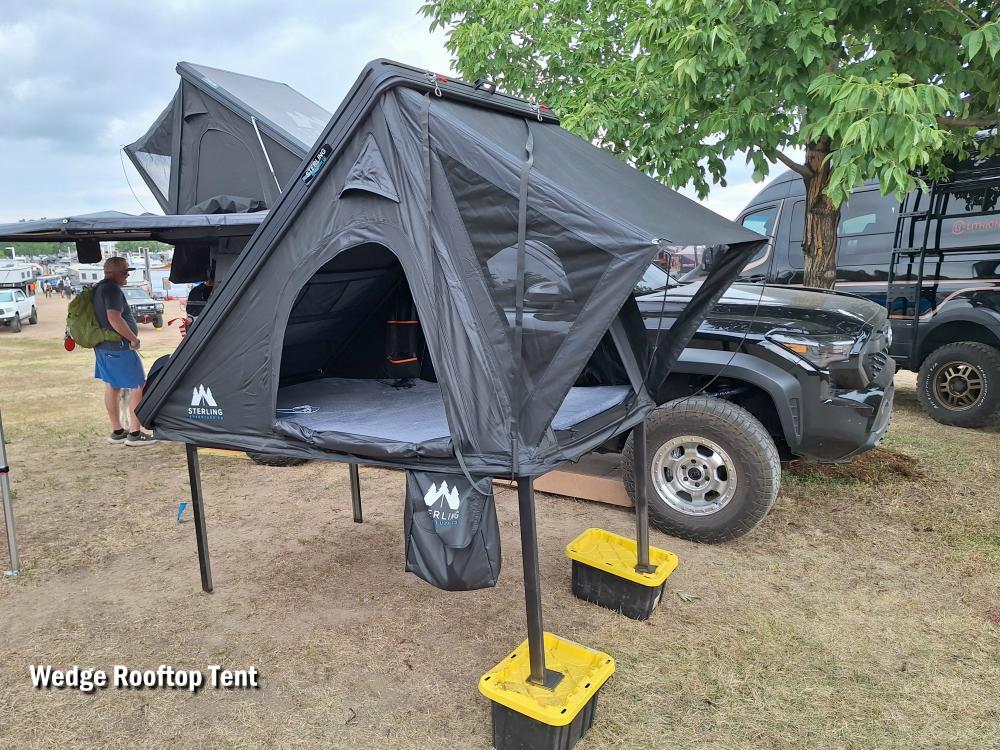
Some of The Most Popular Roof Top Tents (RTT)
| Model / Brand | Key Features |
Weight lbs |
People | Why Popular |
|---|---|---|---|---|
| iKamper Skycamp 2.0 | Hard-shell, quick setup,
roomy interior |
140-180 | 2-4 | Comfort & fast deployment;
premium build quality |
| Yakima SkyRise HD | Soft/hybrid options,
durable fabrics, good ventilation |
120-160 | 2-3 | Balanced size and durability;
strong dealer network |
| Smittybilt Gen2 Overlander XL | Budget-friendly,
large footprint, simple hardware |
160-200 | 2-3 | Value option for buyers who
want space on a budget |
| Roofnest Meadowlark | Light hard-shell,
compact closed dimensions |
85-100 | 2 | One of the lightest quality RTTs
good for smaller roof loads |
| Roofnest Condor / Falcon | Hard-shell, fast open,
good ventilation |
125-175 | 2-3 | Reliable hard-shell option with
strong user reviews |
| Intrepid Camp Gear Geo Solo | Premium soft-shell option;
high-quality fabrics |
130-170 | 1-2 | Premium materials and custom
features for discerning buyers |
Pros & Cons RoofTop Tent VS Ground Tent
| Feature | Rooftop Tent (RTT) | Ground Tent |
|---|---|---|
| Setup / Teardown | Usually faster; open/close with ladder; minimal staking. | Slower; requires clearing ground, staking, sometimes longer to pitch. |
| Comfort & Sleep Surface | Built-in mattress; insulated from ground; more consistent sleep surface. | Depends on pads/mattress; susceptible to ground slope/bumps. |
| Vehicle Dependency | Tied to vehicle — can’t drive away without teardown (unless using bed racks/clever systems). | Independent — you can leave tent and move vehicle if needed. |
| Weight & Fuel Impact | Added weight up high; increases drag and center-of-gravity; reduces fuel economy. | Lower mounted or stored in bed — less impact on handling and fuel. |
| Terrain Suitability | Excellent for rocky/wet/uneven ground — you camp above the ground. | Needs decent ground; puddles, slopes, rocks cause problems. |
| Cost | Higher upfront cost (tent + rack + mounts). | Generally more affordable; wide price range. |
| Capacity & Space | Usually more compact interior — limited standing room; some models allow annexes. | More flexible interior space; larger family tents available; more headroom options. |
| Exposure & Safety | Elevated — fewer ground pests; better in floods/wet ground; ladder access can be limiting. | More exposed to ground moisture, critters; easier access but less protection vs flooding. |
| Durability & Maintenance | Generally robust materials; exposed to sun/UV when mounted; needs care when storing. | Varies widely — cheap tents wear faster; heavy canvas/quality tents last long if cared for. |
Key Specs / Constraints for a Ford Ranger + What to Look For
| Spec | Why It Matters | Typical Ranger Consideration |
|---|---|---|
| Roof Load (Dynamic & Static) | Determines what weight you can carry while driving (dynamic) and when parked (static) — safety & warranty issues. | Check Ranger owner’s manual & rack specs. Typical dynamic ~80–100 kg (175–220 lb) but confirm your year/model and rack. |
| Rack Strength & Mounting System | Heavier RTTs need sturdy racks (crossbars alone may be insufficient). | Consider bolt-on racks, bed racks, or reinforced crossbars for heavier/hard-shell RTTs. |
| Vehicle Clearance & Closed Height | Closed height must fit under garages/trees; open height affects wind profile and handling. | Measure closed height + roof accessories; account for antennae, gutters, and low branches. |
| Sleeping Footprint | Make sure the open sleeping area fits occupants comfortably. | Compare mattress dimensions to intended sleepers (2 adults? 3?). |
| Mounting Footprint / Overhang | Tent footprint must fit crossbar spacing — overhang past the windshield or tailgate can be problematic. | Check tent base dimensions vs your rack crossbar spacing; bed racks change options. |
| Driving Dynamics | High mounted weight changes handling and increases wind noise & fuel use. | Prefer lighter tents if you do a lot of highway driving; hard-shells are heavier but quicker to open. |
So Why Did I Choose Another Ground Tent vs. a Rooftop Tent
Size: A rooftop tent is generally only tall enough to sit up in, which makes getting dressed a challenge. With a ground tent, I can stand up, move around, and change clothes with ease. A ground tent also takes up far less room than an RTT, leaving more space for other essentials. The extra height of rooftop tents—combined with how high they’re mounted above the cab—can also create additional drag, which may affect fuel economy.
Weight: A typical four-person ground tent weighs 20–30 pounds compared to the 120–180 pounds of most rooftop tents. Weight matters because you don’t want to overload your truck. It’s not just about staying under the payload rating—it’s also about efficiency and safety. More weight means reduced mileage, extra strain on the engine when climbing steep grades, and more stress on the brakes when coming down. For reference, the payload capacity of a 2000 Ford Ranger is 1,260 pounds, while a 2019 Ford Ranger is rated at 1,860 pounds. Those numbers sound generous, but once you add water, fuel, a fridge or cooler with food, camping gear, and the weight of passengers, the margin shrinks quickly. Don’t forget to add in the weight of the winch, bumpers and other accessories you added as well.
Center of Gravity: This ties into weight but is important enough to stand alone. Rooftop tents raise a vehicle’s center of gravity, making it more top-heavy and therefore more prone to tipping. On off-camber mountain trails where your rig leans to the side, an extra 180 pounds on the roof is not your friend. In those moments, you’ll wish that weight was a 20-pound tent sitting securely in your truck bed.
Cost: Rooftop tents typically start at around $1,200, while my Caddis tent cost just $240. That’s nearly a $1,000 savings—enough to buy a 12-volt refrigerator and other camping gear. If you really want an RTT but are on a budget, check Facebook Marketplace. I often see lightly used RTTs listed for $600–$700, usually because the owners realized they don’t camp often enough to justify hauling a 180-pound tent around all year.
Mobility: With a ground tent, I can throw it into any vehicle I want, or set it up under trees in a national forest campground for natural shade and wind protection. If the tent is mounted to my truck, I’m limited to wherever I can park. During a trip in Colorado, strong winds blew through camp one night, and I was thankful for the trees breaking the gusts. An RTT would have taken the full force. I also like the freedom of being able to use my truck during camp. With a rooftop tent, I’d have to pack it up every time I wanted to drive.
Durability: My own experience sealed the deal. After several days of rough roads on the Trans America Trail, I opened my rooftop tent to find it falling apart. The constant vibration had shaken nuts and bolts loose, and some had even fallen out. That was enough to make me reconsider whether an RTT was worth the hassle.
If I Got a Rooftop Tent, What Style Would I Choose
If I were to buy a rooftop tent, I’d go with a wedge style like the Sterling Wasatch Rooftop Tent pictured below. The wedge and clamshell designs are similar, but with one key difference: clamshells typically only have a door at the end, while a wedge gives you both an end door and a side door for easier access. The Sterling, for example, has an aluminum shell, measures just 4.7 inches tall when closed, and weighs only 96 pounds. When opened, it expands to 83″ x 51″ x 52″, which is more than enough room for someone my height.
What I like most about this style is that it’s lighter than most rooftop tents and far slimmer when closed, meaning it won’t stick up like a sail and create unnecessary drag on the highway. That makes it more efficient and less intrusive than bulkier designs.
Yes, wedge tents are more expensive than soft shell RTTs, but in my opinion, the trade-off is worth it. Soft shells tend to be heavy, bulky, and frustrating when it comes time to wrestle the cover back on and zip it up. The only time I’d recommend a soft shell is if you can score one used on Facebook Marketplace for around $600—otherwise, I don’t think they justify the investment.
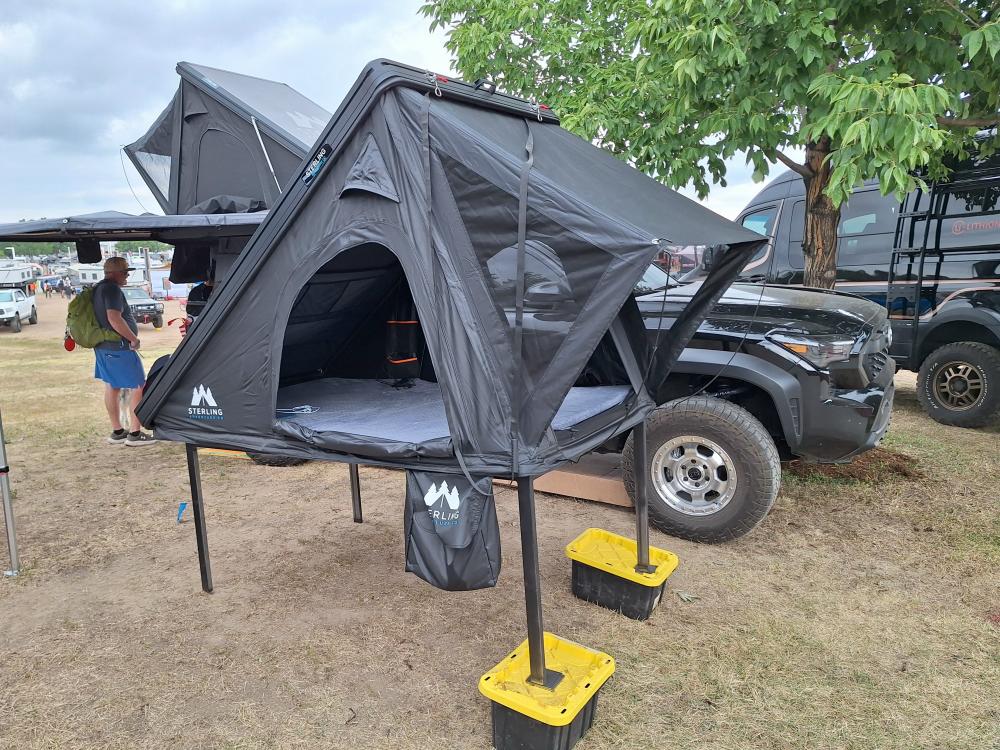
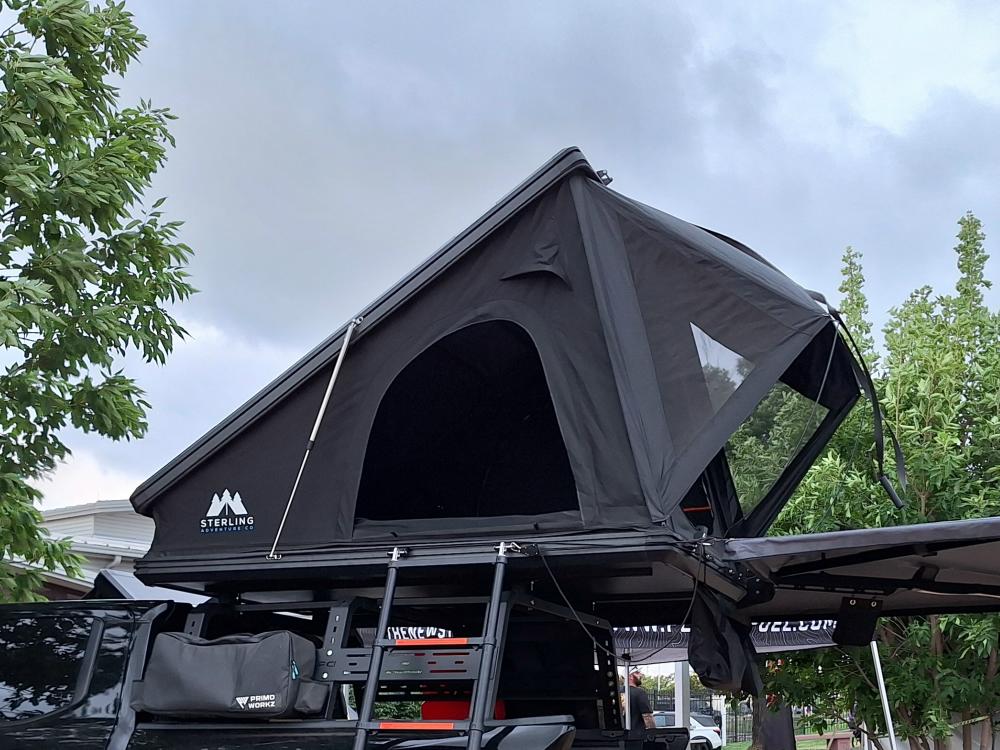
Conclusion & Recommendations
My practical takeaways:
- If you frequently camp where the ground is uneven, rocky, or wet — and you value quick setup and a consistent sleep surface — a rooftop tent is a solid choice.
- If you need flexibility (leave camp and drive the vehicle or want to be able to camp away from the vehicle), weight savings, or lower cost — a modern instant ground tent is an excellent solution.
- Consider your truck’s roof/bed load capacity and how often you’ll use the tent. If you only camp a few times a year, the cost and added drag of an RTT may not be worth it.
- Test with a rental or borrowed RTT first if possible — that experience alone often answers the question for many users.
Whatever you choose, think about how the tent fits into your overall build: roof racks, bed racks, storage strategy, and the weight you plan to carry. My personal preference has shifted depending on trip type — long-haul routes with lots of stops I’ve liked the RTT convenience; shorter trips or family basecamps I’ve favored modern ground tents for space and flexibility. But mostly, I like the lighter weight of a ground tent and the better fuel mileage, and I like to be able to be able to camp under the trees and not on the back of my truck in a parking lot (not all campgrounds let you park on your tent site).
About The Author
Jim Oaks is the founder of The Ranger Station, one of the longest-running Ford Ranger enthusiast communities on the web. He has spent over three decades owning, modifying, repairing, and driving Ford Rangers on the street, trail, and cross-country routes.
Since launching TheRangerStation.com in 1999, Jim has documented thousands of real-world Ranger builds, technical repairs, drivetrain swaps, suspension modifications, and off-road tests contributed by owners worldwide. His work has been referenced by enthusiasts, mechanics, and off-road builders looking for practical, experience-based information rather than theoretical advice.
Jim’s hands-on experience includes long-distance overland travel, trail use, drivetrain and axle upgrades, suspension tuning, and platform comparisons across multiple Ranger generations. The content published on The Ranger Station is grounded in first-hand experience and community-verified data, not marketing claims or generic specifications.

